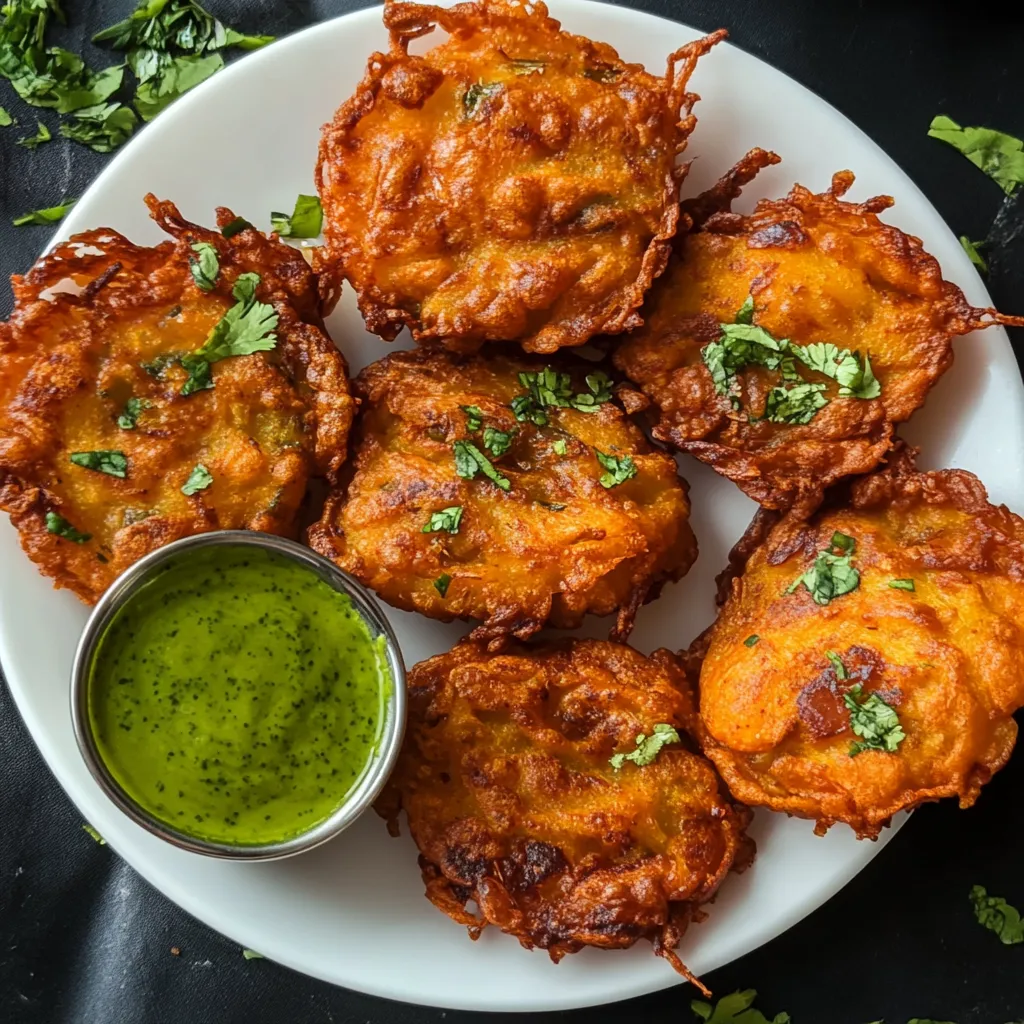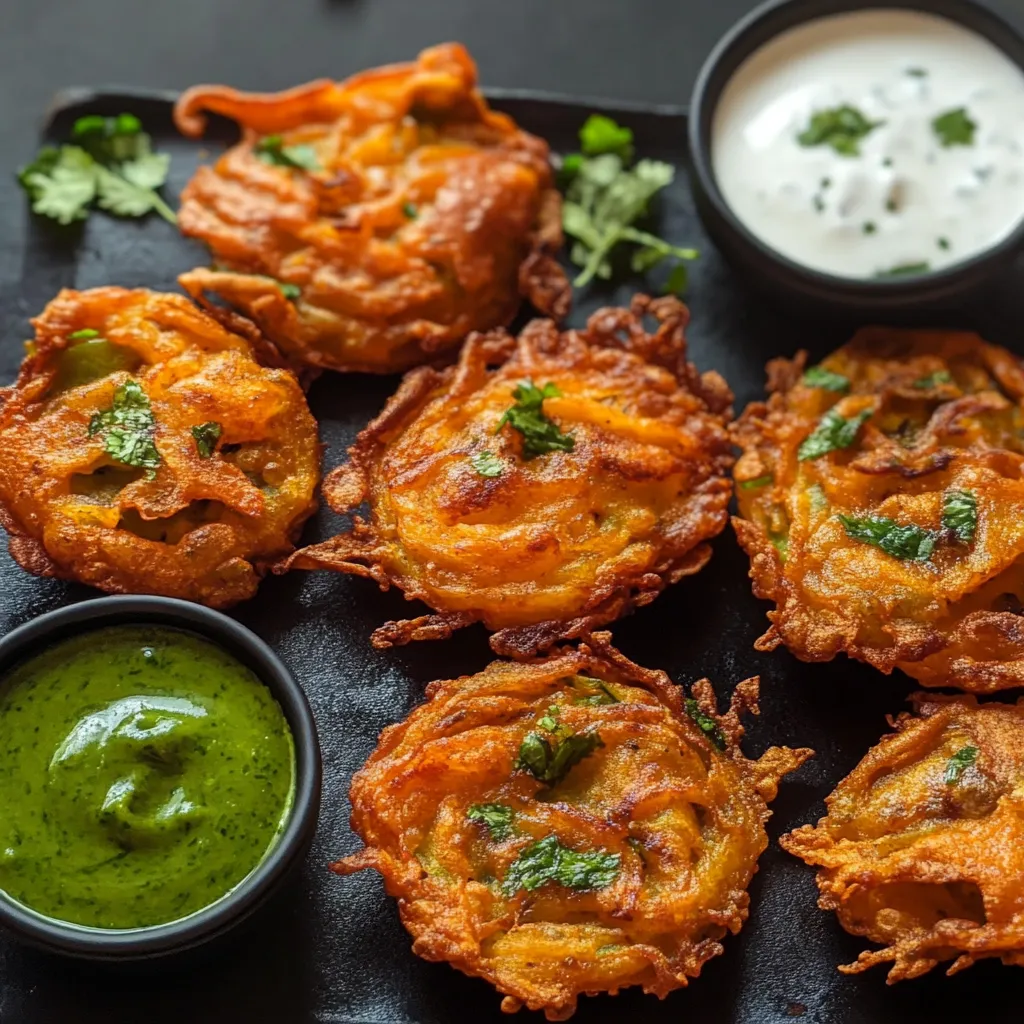 Pin it
Pin it
This crispy, fragrant onion bhaji recipe transforms simple ingredients into the most addictive Indian street food snack you'll ever make at home. The golden, crunchy exterior gives way to tender spiced onions that deliver an explosion of authentic flavor with every bite.
I first made these onion bhajis after returning from a trip to Mumbai where I fell in love with street food. Years later, this recipe still transports me back to those bustling market stalls with just one bite.
Ingredients
- Red onions: Sliced perfectly to ensure proper texture and cooking. Their natural sweetness balances the spicy elements
- Fresh cilantro: Adds bright herbaceous notes that complement the earthy spices
- Green chilies: Provide adjustable heat. Remove seeds for milder flavor
- Gram flour (besan): Creates the signature crisp exterior and helps bind everything together
- Kashmiri red chili powder: Contributes beautiful color without overwhelming heat
- Ground cumin and coriander: Form the aromatic foundation of authentic Indian flavor
- Turmeric: Adds golden color and subtle earthy notes that enhance overall depth
Step-by-Step Instructions
- Slice the Onions:
- Cut 1 to 2 large red onions lengthwise into thin strips. This cutting direction is crucial as it allows the onions to maintain their structure during frying while absorbing maximum flavor from the spices. The goal is long strands rather than diced pieces.
- Prepare the Vegetables:
- Add the sliced onions to a large mixing bowl along with 1/2 cup finely chopped cilantro and 3 to 4 finely diced green chilies. The fresh herbs and chilies will perfume the entire mixture while adding complexity to the final result.
- Season Generously:
- Sprinkle all the spices over the onion mixture including salt, black pepper, Kashmiri red chili powder, coriander powder, cumin and turmeric. Mix thoroughly with your hands or a large spoon until every onion strand is evenly coated with the aromatic spice blend.
- Create the Batter:
- Add 1 cup of gram flour to the seasoned onions and mix gently. Pour in water gradually, starting with 1/4 cup and adding more as needed. The ideal consistency is slightly runnier than pancake batter just enough to lightly coat the onions without creating heavy doughy clumps.
- Heat the Oil:
- In a deep heavy bottomed pan or wok, heat oil to 350°F. The temperature is critical too hot and the bhajis will brown before cooking through too cool and they will absorb excess oil and become greasy.
- Fry to Perfection:
- Take a handful of the battered onions and gently drop them into the hot oil. Do not compress the mixture the scraggly, loose texture creates the signature crispy exterior. Fry in small batches to maintain oil temperature, turning occasionally until golden brown on all sides, approximately 3 to 4 minutes.
- Drain and Serve:
- Remove the bhajis with a slotted spoon and place on paper towels to absorb excess oil. Serve immediately while still hot and crispy for the ultimate experience.
 Pin it
Pin it
My grandmother taught me to always let the spices bloom on the onions before adding the gram flour this simple step makes all the difference in developing those complex flavors. When I make these now, the aroma instantly takes me back to her kitchen where I first learned to cook Indian cuisine.
Storage and Reheating
Onion bhajis are best enjoyed fresh from the fryer while still hot and ultra crispy. However, if you need to make them ahead, store cooled bhajis in an airtight container in the refrigerator for up to 2 days. Reheat them in a 350°F oven for 5 to 7 minutes to restore their crispness avoid microwaving as it will make them soggy.
Perfect Pairings
The traditional way to enjoy onion bhajis is with mint chutney or tamarind chutney. The cooling mint provides perfect contrast to the warm spices, while tamarind offers sweet and tangy notes that complement the savory fritters. A simple raita yogurt sauce with cucumber and a touch of cumin also makes an excellent dipping option.
Customization Ideas
While this recipe provides the classic onion bhaji experience, you can easily customize it to your preferences. Add finely chopped spinach, grated carrot, or corn kernels to the batter for vegetable variations. For protein packed versions, incorporate 1/4 cup of finely chopped paneer. Adjust the heat level by increasing or decreasing the green chilies according to your spice tolerance.
 Pin it
Pin it
These onion bhajis are the perfect way to bring authentic Indian flavors to your table—give them a try and impress your family and friends!
Frequently Asked Questions
- → What is the difference between Bhaji and Pakora?
While both terms are sometimes used interchangeably, bhajis typically refer to fritters where the main ingredient (onions in this case) is sliced and visible in a scraggly formation, while pakoras often contain finely chopped or grated vegetables fully encased in batter. Bhajis tend to be lighter and crispier, while pakoras can be slightly denser.
- → Can I make these without deep frying?
Yes, you can make a healthier version by shallow frying in less oil or using an air fryer. For air fryer, spray the bhajis with oil and cook at 375°F for about 12-15 minutes, flipping halfway through. The texture won't be exactly the same but still delicious.
- → What can I serve with onion bhaji?
Onion bhajis pair wonderfully with mint-coriander chutney, tamarind chutney, or yogurt raita. They're commonly served as an appetizer or snack with a hot cup of chai tea, or as part of a larger Indian meal.
- → Can I prepare the batter in advance?
You can prepare the dry spice mixture and chop the onions in advance, but it's best to mix the batter right before frying. If mixed too far ahead, the onions will release water and make the batter too wet, affecting the final crispiness of the bhajis.
- → What is gram flour/besan and can I substitute it?
Gram flour (besan) is made from ground chickpeas and gives bhajis their distinctive flavor and texture. While traditional bhajis use gram flour, you could substitute with chickpea flour (same thing, different name) or a mix of all-purpose flour and rice flour as an alternative, though the taste and texture will be different.
- → How do I know when the oil is at the right temperature?
Without a thermometer, you can test if the oil is ready by dropping a small amount of batter into it. If the batter rises to the surface immediately with bubbles around it, the oil is ready. If it sinks or burns quickly, adjust the temperature accordingly.
